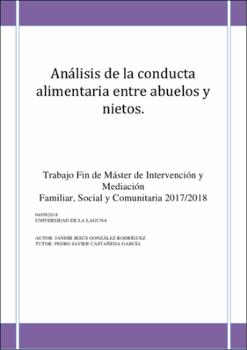Análisis de la conducta alimentaria entre abuelos y nietos
Fecha
2018Resumen
The objective of this work has been to analyze the eating behavior shared by
grandparents and grandchildren. There was a total of 114 volunteers, without physicalcognitive limitations, who were given a questionnaire divided into four parts: a first,
about their sociodemographic characteristics; a second, to know with what general style
of abuelity they are identified (formal, informal and substitute); a third, to indicate a list
of foods that they share with their grandchildren, which cause more or less overweight
and obesity, (Wolever, 2008); and as a last part, several sub-scales of the CFPQ of
Musher-Eizenman & Holub (2007), which analyzes different intergenerational feeding
practices. After analyzing the data through χ² and ANOVAS, the results show that the
most frequent type of abuelity is formal, followed by informal and substitute. In relation
to the food shared by grandparents and grandchildren, we observed that, regardless of
the role of grandparent, they consume foods with a high glycemic index more
frequently, as they have a high content of sugar and fats that can generate many health
problems in the future. Finally, after analyzing the feeding practices extracted from the
CFPQ subscales, the grandparents are more in agreement to project a model of healthy
eating, however, they use undesirable eating patterns such as the use of food as a
reward, pressure and use of food to regulate the emotions of their grandchildren. These
practices are more frequent in substitute and informal grandparents. It can be concluded
that, from this exploratory study, grandparents have a great potential to influence the
feeding of their grandchildren, so they should develop preventive family intervention
plans, adapted and adapted to these influential members in families current El objetivo de este trabajo ha sido analizar la conducta alimentaria que
comparten abuelos y nietos. Se ha contado con un total de 114 personas voluntarias, sin
limitaciones físico-cognitivas, a las que se les pasó en sus casas un cuestionario dividido
en cuatro partes: una primera, sobre sus características sociodemográficas; una segunda,
para saber con qué estilo general de abuelidad se identifican (formal, informal y
sustituto); una tercera parte, para señalar una lista de alimentos que comparten con sus
nietos, que causan mayor o menor sobrepeso y obesidad, (Wolever, 2008); y como
última parte, varias sub-escalas del CFPQ de Musher-Eizenman & Holub (2007), que
analiza distintas prácticas de alimentación intergeneracionales. Tras analizar los datos
mediante χ² y ANOVAS, los resultados ponen de manifiesto que el tipo de abuelidad
más frecuente es el formal, seguido del informal y sustituto. En relación a la
alimentación que comparten los abuelos y nietos observamos que, independientemente
del rol de abuelidad, consumen con mayor frecuencia alimentos con alto índice
glucémico, al tener gran contenido de azúcar y grasas que pueden generar en el futuro
muchos problemas de salud. Por último, tras analizar las prácticas de alimentación
extraídas de las subescalas del CFPQ, los abuelos están más de acuerdo en proyectar un
modelo de alimentación saludable, sin embargo, utilizan pautas de alimentación
desaconsejables como el uso de la comida como recompensa, presión y el uso de los
alimentos para regular las emociones de sus nietos. Dichas prácticas son más frecuentes
en los abuelos sustitutos e informales. Se puede concluir que, a partir de este estudio
exploratorio, los abuelos tienen un gran potencial para influir sobre la alimentación de
sus nietos, por lo que se deben desarrollar planes preventivos de intervención familiar,
adaptados y adecuados a estos miembros tan influyentes en las familias actuales.




